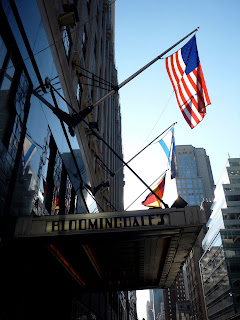Flagships of New York: The Great Department Stores
 |
| Bloomingdale's, 59th St. and Lexington Ave. |
A similar timeless scene may have been unfolding at the other stores nearby - at Henri Bendel, Barney's New York, Bergdorf Goodman, or Saks, or farther south at Lord & Taylor on Fifth Avenue, or in Herald Square at Macy's. With Bloomingdale's and Barney's as important exceptions, Fifth Avenue has long been a preferred site for department stores, long ago known as dry goods stores, and they now seem entrenched and full established after their long migration from downtown and Ladies' Mile.
 |
| former B. Altman store, Fifth Avenue, between E. 34th and E. 35th, now CUNY Graduate Center |
Ironically, for someone who often writes in the tradition of the flâneuse, the female equivalent of the gentlemen who strolled the streets of Paris in the nineteenth century, the rise of department stores spells a kind of death by bourgeois consumerism. The great European cultural critic Walter Benjamin wrote famously of the flâneurs roaming the novel arcades of Charles Baudelaire's Paris of the 1820s through 1850s, these fabulous enclosed indoor shopping passageways with roofs of glass and iron lined with stores of luxury goods. The arcade's successor, the department store, removed the street in favor of surrounding the flâneur with commodities. In his 1938 essay, "The Paris of the Second Empire in Baudelaire," Benjamin writes "The department store is the last promenade of the flâneur."
Origins in New York
In 1823 Alexander Turney Stewart (1803-1876), one of the most important merchants in New York history, dropped his original plans to become a minister and traveled to New York City from his native Ireland. Using an inheritance to buy Belfast linens and lace for resale in New York, Stewart opened a store for dry goods at 283 Broadway. The store often showed its merchandise along the sidewalk in front of the building, a form of advertising that is still popular today. Within twenty years he was ready for a major expansion.
 |
| Stewart's "Marble Palace" at the northeast corner of Broadway and Chambers Street now houses city offices. |
In 1846 Stewart opened what became known as the "Marble Palace" at 280 Broadway (above) on the northeast corner of Broadway and Chambers Street, a store that specialized in European women's fashion. Built in marble in the Renaissance Revival style, the store is considered the fist department store as well as a design precedent for hundreds of buildings to follow. According to New York Architecture, "The former A.T. Stewart Store was one of the most influential buildings ever erected in New York City, as its style, materials, use, and location helped determine the course of architecture and commerce in the city."
In 1862 Stewart built the enormous "Palace," a cast iron building that took up a whole block on Broadway from 9th to 10th St. Other merchants followed Stewart northward. By the late 1870s two thousand people worked in thirty departments within the store. (source: Columbia Encyclopedia) The increasing construction of department stores, many massive and elaborate structures such as the Siegel Cooper Dry Goods Store (1896), established Ladies' Mile as one of the most important shopping districts in the country.
 |
| originally Arnold Constable Dry Goods Store, now ABC Carpet Store, Broadway side near E. 19th St. |
Many of the grand buildings of Ladies' Mile still thrive as the location for contemporary businesses, including ABC Carpet (a store originating on the Lower East Side in 1897), Home Depot, and a particularly stunning Bed, Bath & Beyond in the old Siegel-Cooper building on Sixth Avenue at 18th Street. The B. Altman Dry Goods Store across the way from the Siegel-Cooper building now houses a branch of the Container Store. Ladies' Mile was eventually left behind in the early twentieth century. B. Altman and Lord & Taylor were among the first department stores to move to the new wealthy blocks of residential Fifth Avenue.
Read all the posts in this series, Flagships of New York:
Images by Walking Off the Big Apple, whose college friends enjoyed calling a "Neiman-Marxist."http://www.walkingoffthebigapple.com/2009/11/thin-man-walk-new-york-holiday_25.html






Comments
Post a Comment